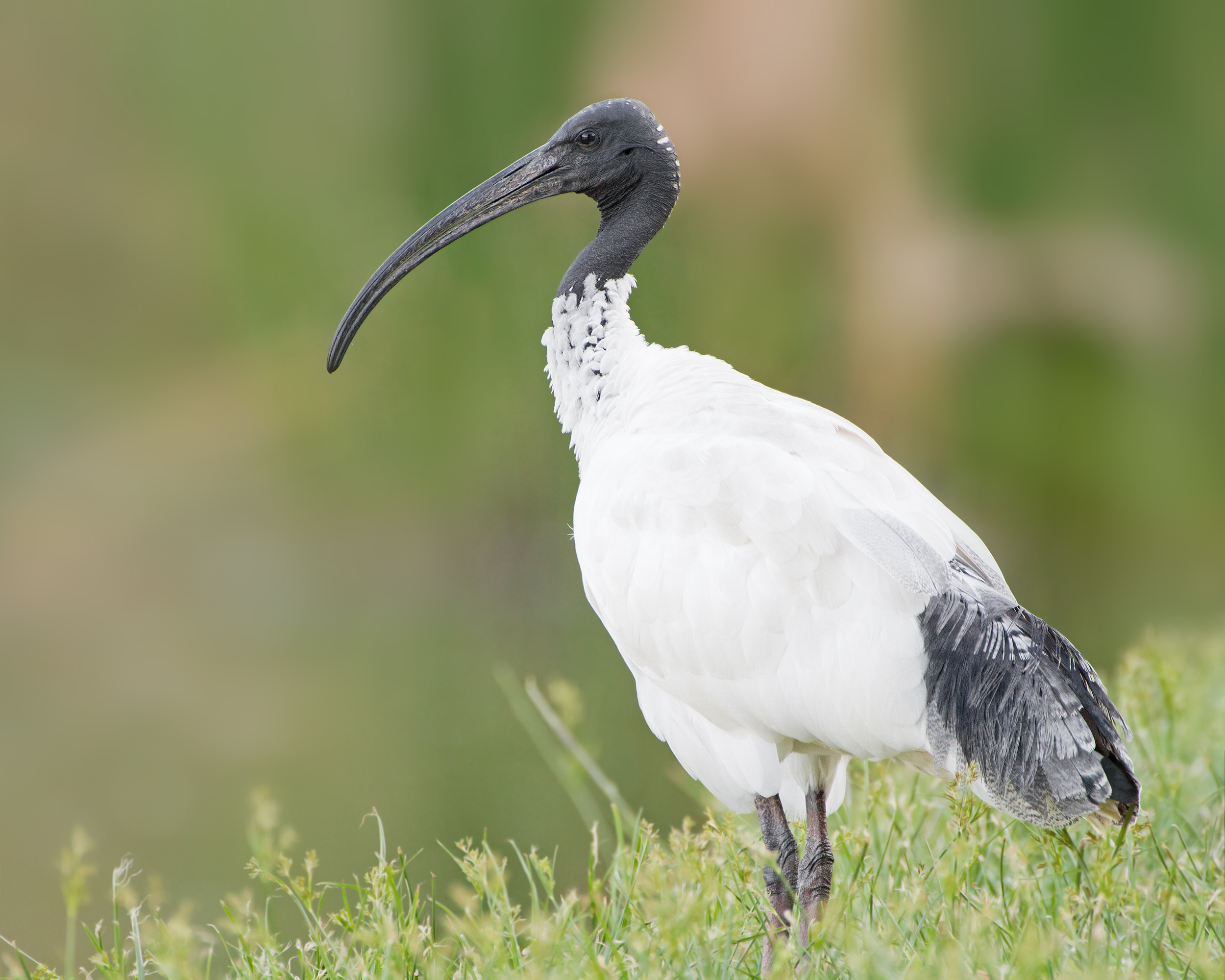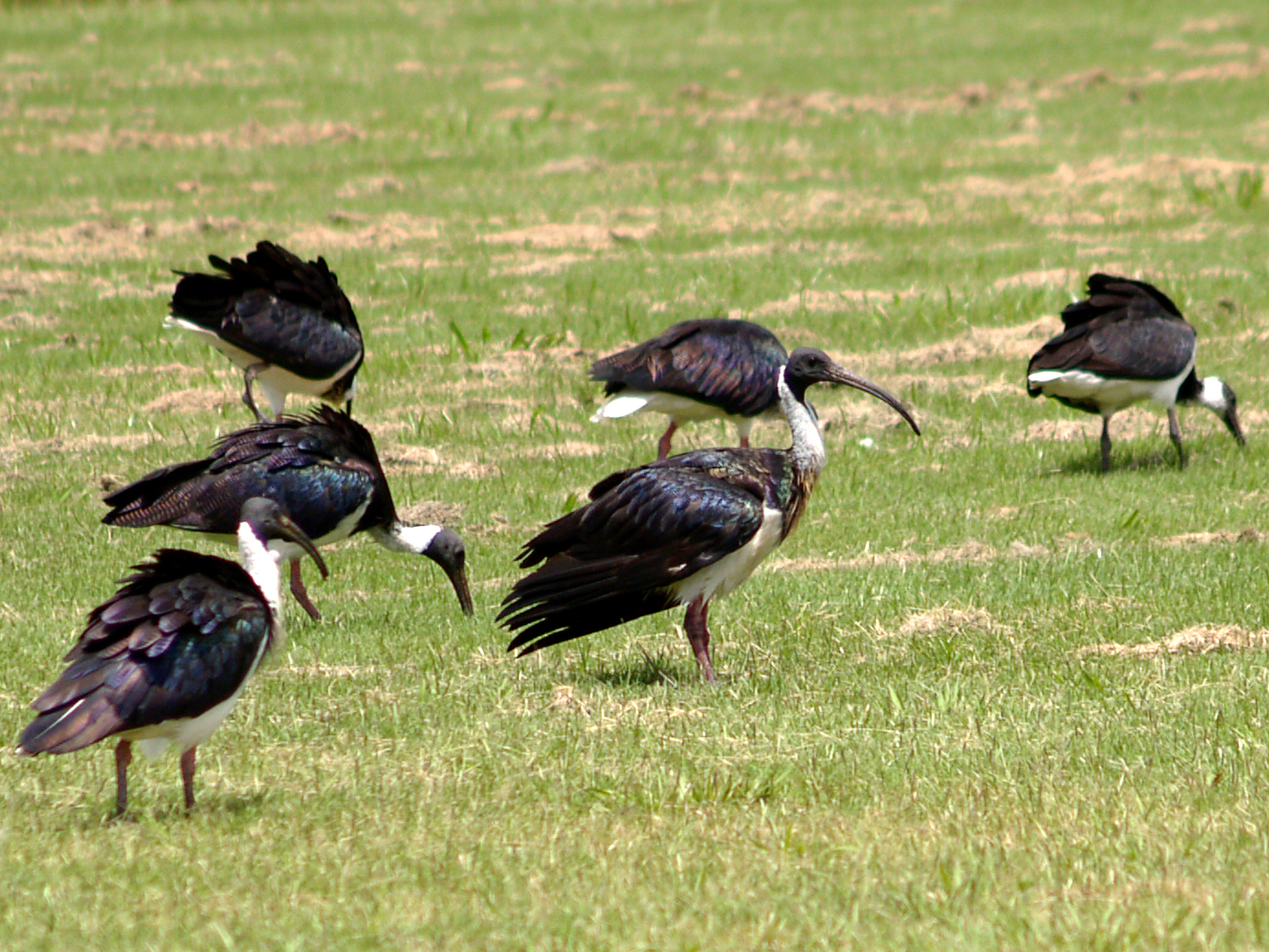|
Threskiornis
''Threskiornis'' is a genus of ibises, wading birds of the family Threskiornithidae. They occur in the warmer parts of the Old World in southern Asia, Australasia and Sub-Saharan Africa. They are colonial breeders, which build a stick nest in a tree or bush and lay two to four eggs. They occur in marshy wetlands and feed on various fish, frogs, crustaceans and insects. In English, they are called sacred ibises. In Australia, urban dwelling ibises are known colloquially as "bin chickens". Description Adult ''Threskiornis'' ibises are typically 75 cm long and have white body plumage. The bald head, neck and legs are black. The bill is thick and curved. Sexes are similar, but juveniles have whiter necks duller plumage. The straw-necked ibis The straw-necked ibis (''Threskiornis spinicollis'') is a bird of the ibis and spoonbill family Threskiornithidae. It can be found throughout Australia, New Guinea, and parts of Indonesia. Adults have distinctive straw-like feathers on ... [...More Info...] [...Related Items...] OR: [Wikipedia] [Google] [Baidu] |
African Sacred Ibis
The African sacred ibis (''Threskiornis aethiopicus'') is a species of ibis, a wading bird of the family Threskiornithidae. It is native to much of Africa, as well as small parts of Iraq, Iran and Kuwait. It is especially known for its role in Ancient Egyptian religion, where it was linked to the god Thoth. The species is currently extirpated from Egypt. Taxonomy It is very closely related to the black-headed ibis and the Australian white ibis, with which it forms a superspecies complex, so much so that the three species are considered conspecific by some ornithologists. In mixed flocks these ibises often hybridise. The Australian white ibis is often called the sacred ibis colloquially. Although known to the ancient civilisations of Greece, Rome and especially Africa, ibises were unfamiliar to western Europeans from the fall of Rome until the 19th century, and mentions of this bird in the ancient works of these civilisations were supposed to describe some type of curlew ... [...More Info...] [...Related Items...] OR: [Wikipedia] [Google] [Baidu] |
Australian White Ibis
The Australian white ibis (''Threskiornis molucca'') is a wading bird of the family (biology), family Threskiornithidae. It is widespread across much of Australia. It has a predominantly white plumage with a bare, black head, long downcurved bill, and black legs. While it is closely related to the African sacred ibis, the Australian white ibis is a Birds of Australia, native Australian bird. Contrary to Urban legend, urban myth, it is not a Introduced species, feral species introduced to Australia by people, and it does not come from Egypt. Historically rare in urban areas, the Australian white ibis has established in urban areas of the east coast in increasing numbers since the late 1970s; it is now commonly seen in Wollongong, Sydney, Melbourne, Adelaide, Darwin, Northern Territory, Darwin, the Gold Coast, Queensland, Gold Coast, Brisbane and Townsville. In recent years, the bird has also become increasingly common in Perth, Western Australia, and surrounding towns in south-w ... [...More Info...] [...Related Items...] OR: [Wikipedia] [Google] [Baidu] |
Black-headed Ibis (Threskiornis Melanocephalus)
The black-headed ibis (''Threskiornis melanocephalus''), also known as the Oriental white ibis, Indian white ibis, and black-necked ibis, is a species of wading bird of the ibis family Threskiornithidae which breeds in the South and Southeast Asia from India to the west and as far east as Japan. It is the only native ibis species in its range that has an overall white plumage with a black neck and head. The down-curved beak and legs are also black. Though often referred to as a wetland species, the black-headed ibis forages in a range of natural and man-made habitats. This species of ibis nests only during the rainy season. Description The black-headed ibis is one of several large waterbird species in south and south-east Asia, with adults measuring 65–76 cm in length. The white plumage is starkly contrasted against a conspicuous naked black neck and head, and black down-curved beak. Tails of adults bear light grey ornamental feathers that turn jet black during the breed ... [...More Info...] [...Related Items...] OR: [Wikipedia] [Google] [Baidu] |
Ibis
The ibis () (collective plural ibises; classical plurals ibides and ibes) are a group of long-legged wading birds in the family Threskiornithidae that inhabit wetlands, forests and plains. "Ibis" derives from the Latin and Ancient Greek word for this group of birds. It also occurs in the scientific name of the western cattle egret (''Ardea ibis'') mistakenly identified in 1757 as being the sacred ibis. Description Ibises all have long, downcurved bills, and usually feed as a group, probing mud for food items, usually crustaceans. They are monogamous and highly territorial while nesting and feeding. Most nest in trees, often with spoonbills or herons. All extant species are capable of Flying and gliding animals, flight, but two extinct genera were flightless, namely the kiwi-like ''Apteribis'' in the Hawaiian Islands, and the peculiar ''Xenicibis xympithecus, Xenicibis'' in Jamaica. The word ''ibis'' comes from Latin ''ibis'' from Ancient Greek, Greek ἶβις ''ibis'' from Egy ... [...More Info...] [...Related Items...] OR: [Wikipedia] [Google] [Baidu] |
Straw-necked Ibis
The straw-necked ibis (''Threskiornis spinicollis'') is a bird of the ibis and spoonbill family Threskiornithidae. It can be found throughout Australia, New Guinea, and parts of Indonesia. Adults have distinctive straw-like feathers on their necks. Description Straw-necked ibises are large birds, around long, with a bare black head and a long, downcurved black bill. They have a distinctive, highly iridescent plumage, which can appear fairly uniform dirty dark brown in indifferent light; the wings are dark, with an iridescent, multicoloured sheen in sunlight. They have a shiny blue-black back, with a metallic purple, green and bronze glow, and a dark collar. The upper neck is white, as are the underparts and the undertail; their legs are usually red near the top and dark grey toward the feet. Adults have straw-colored feathers on the neck, giving the bird its common name. Their wingspan is about and weight is generally . Sexes are similar, although males have longer bills and ... [...More Info...] [...Related Items...] OR: [Wikipedia] [Google] [Baidu] |
Threskiornithidae
The family Threskiornithidae includes 36 species of large wading birds. The family has been traditionally classified into two subfamilies, the ibises and the spoonbills; however, recent genetic studies have cast doubt on this arrangement, and have found the spoonbills to be nested within the Old World ibises, and the New World ibises as an early offshoot. Taxonomy The family Threskiornithidae was formerly known as Plataleidae. The spoonbills and ibises were once thought to be related to other groups of long-legged wading birds in the order Ciconiiformes. A recent study found that they are members of the order Pelecaniformes. In response to these findings, the International Ornithological Congress (IOC) recently reclassified Threskiornithidae and their sister taxa Ardeidae under the order Pelecaniformes instead of the previous order of Ciconiiformes. Whether the two subfamilies are reciprocally monophyletic is an open question. The South American Checklist Committee's entry for th ... [...More Info...] [...Related Items...] OR: [Wikipedia] [Google] [Baidu] |
Threskiornis Aethiopicus -Mida Creek Mud Flats, Kenya-8
''Threskiornis'' is a genus of ibises, wading birds of the family Threskiornithidae. They occur in the warmer parts of the Old World in southern Asia, Australasia and Sub-Saharan Africa. They are colonial breeders, which build a stick nest in a tree or bush and lay two to four eggs. They occur in marshy wetlands and feed on various fish, frogs, crustaceans and insects. In English, they are called sacred ibises. In Australia, urban dwelling ibises are known colloquially as "bin chickens". Description Adult ''Threskiornis'' ibises are typically 75 cm long and have white body plumage. The bald head, neck and legs are black. The bill is thick and curved. Sexes are similar, but juveniles have whiter necks duller plumage. The straw-necked ibis differs from the other species in having dark upperparts, and is some times placed in the separate genus ''Carphibis'' ( Jameson, 1835) as ''Carphibis spinicollis''. A flightless species, the Reunion ibis Reunion may refer to: * Class ... [...More Info...] [...Related Items...] OR: [Wikipedia] [Google] [Baidu] |
Malagasy Sacred Ibis
The Malagasy sacred ibis (''Threskiornis bernieri'') is a relatively large, heavily built ibis endemic to the west coast of Madagascar, and Aldabra on the Seychelles. Taxonomy and systematics The Malagasy sacred ibis was formerly considered a subspecies of the African sacred ibis.Holyoak D. 1970. Comments on the classification of the Old World ibises. Bulletin of the British Ornithologists' Club 90: 67-73.Hancock JA, Kushlan JA, Kahl MP. 1992. Storks, Ibises and Spoonbills of the World. Academic Press. It is now however classified as a separate species from the African sacred ibis due to considerable differences observed in the former's ecology and morphology.Andrianarimisa A, Razafimanjato G. 2010. Madagascar sacred ibis Threskiornis bernieri: current population distribution, and implications for conservation. Pp. 120-130. In: Harebottle DM, Craig AJFK, Anderson MD, Rakotomana H, Muchai M.Proceedings of the 12th Pan-African Ornithological Congress, 2008. Cape Town, Animal Demogr ... [...More Info...] [...Related Items...] OR: [Wikipedia] [Google] [Baidu] |
George Robert Gray
George Robert Gray (8 July 1808 – 6 May 1872) was an English zoology, zoologist and author, and head of the Ornithology, ornithological section of the British Museum, now the Natural History Museum, London, Natural History Museum, London for forty-one years. He was the younger brother of the zoologist John Edward Gray and the son of the botanist Samuel Frederick Gray. George Gray's most important publication was his ''Genera of Birds'' (1844–49), illustrated by David William Mitchell and Joseph Wolf, which included 46,000 references. Biography He was bornon 8 July 1808 in Little Chelsea, London, to Samuel Frederick Gray, naturalist and pharmacologist, and Elizabeth (née Forfeit), his wife. He was educated at Merchant Taylor's School. Gray started at the British Museum as Assistant Keeper of the Zoology Branch in 1831. He began by cataloguing insects, and published an ''Entomology of Australia'' (1833) and contributed the entomogical section to an English edition of ... [...More Info...] [...Related Items...] OR: [Wikipedia] [Google] [Baidu] |
Sydney
Sydney is the capital city of the States and territories of Australia, state of New South Wales and the List of cities in Australia by population, most populous city in Australia. Located on Australia's east coast, the metropolis surrounds Sydney Harbour and extends about 80 km (50 mi) from the Pacific Ocean in the east to the Blue Mountains (New South Wales), Blue Mountains in the west, and about 80 km (50 mi) from Ku-ring-gai Chase National Park and the Hawkesbury River in the north and north-west, to the Royal National Park and Macarthur, New South Wales, Macarthur in the south and south-west. Greater Sydney consists of 658 suburbs, spread across 33 local government areas. Residents of the city are colloquially known as "Sydneysiders". The estimated population in June 2024 was 5,557,233, which is about 66% of the state's population. Estimated resident population, 30 June 2017. The city's nicknames include the Emerald City and the Harbour City. There is ev ... [...More Info...] [...Related Items...] OR: [Wikipedia] [Google] [Baidu] |









